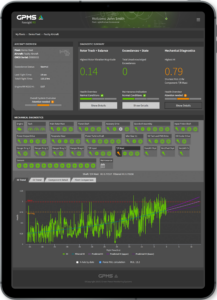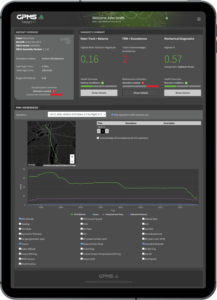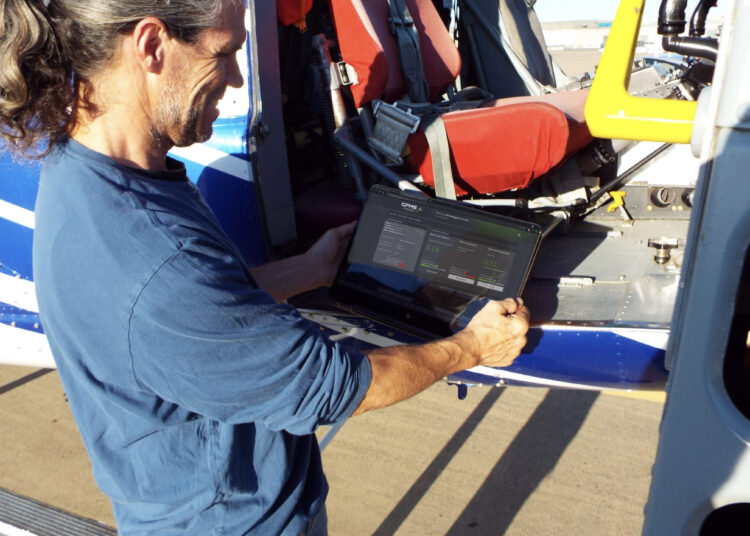What are the current options? What are the benefits and costs?
Firefighting operators, busy with one of the most active seasons on record this year, could have been forgiven for missing the substantial updates embedded in the US Forest Service’s helicopter contract. By September, however, a new draft and the reality of the mandates in the nearly 300-page solicitation set in. As the Government moved to a ‘Lowest Priced, Technically Acceptable’ footing, they dramatically raised the technical standards on aircraft. Among other requirements, Health and Usage Monitoring Systems (HUMS) were specified on “Modern” Type 1, 2, and 3 aircraft.
In mid-December, the Forest Service pushed out implementation of its Multiple Award Task Order Contract (MATOC) changes until 2022. This gives operators looking down the road more time to evaluate what equipment they need in the future.
But the future will be here soon. To help, Aerial Fire asked some core questions about this less well-known product category. Where did HUMS come from, just what is a HUMS system, what do you want to look for and are there any benefits to go along with the costs?
Background: The Problem of Machine Failure
North American operators lacking experience in sectors where HUMS is prevalent, such as military aviation or oil and gas, are often unfamiliar with this avionics category. But the problem these systems are designed to solve -- machine failure -- has been around since the dawn of the machine era.
The science of condition monitoring developed over the course of the 20th century as technologists developed sensors to pick up vibration signals and then math and eventually software code to refine that signal and convert it into a meaningful trend representing machine condition, or health. This work was initially done on industrial machines and the promise was twofold: you could detect an impending failure in time to address it, thus improving reliability and uptime. And, you could adapt maintenance from a one-size-fits-all scheduled program to an on-condition footing in which maintenance was done as needed.
Condition Monitoring Comes to Rotorcraft – Gen 1 HUMS
The problem of machine failure is of course especially critical for helicopters. Military aircraft need to be ready to fly at a moment’s notice. Safety and reliability are prized on machines that can't go down without a serious risk to life and limb. These impulses led to the early adoption of condition monitoring on larger aircraft in both the military services and in offshore oil and gas, where several machine-related accidents in the North Sea generated government requirements for HUMS.

Significantly, large-scale studies done to validate the technology’s operational impact testified to its benefits. Not only did HUMS reduce accidents but it also improved readiness (what commercial operators know as availability) and lowered maintenance costs. The 3rd Aviation Brigade Study, for instance, showed a 30% reduction in mission aborts?, a 20% reduction in maintenance test flights?, and a 5-10% reduction in scheduled maintenance.
But like most first-generation technology, the systems were clunky. Data captured on the aircraft had to be manually offloaded via ‘sneakernet’ to a PC. The trend graphs were so confusing they often required specialized knowledge of signal processing to interpret. And the systems were prone to false positives, leading maintainers to begin, say, a time-consuming extraction only to find a perfectly good part at the end of a disassembly.

But in truth, the biggest complaints (and likely the biggest impediment to widespread adoption) were weight and cost. On the UH60 Blackhawk, for instance, the original health monitoring system was over 100 pounds and cost hundreds of thousands of dollars. Not exactly a viable option for a Bell 407 on a USDA Call When Needed contract.
How HUMS Works
Before we describe system functionality, or what precisely HUMS does, we need to understand system architecture, or how HUMS works. You can break this into five parts -- data acquisition, storage, transfer, analysis, and display.
Historically, onboard sensors acquired vibration signals and stored data in a data acquisition unit. Post-flight, operators then used ethernet or PCMCIA cards to transfer data to a PC. Analysis was done at the DAU and within the locally stored software. And data display was through that same PC ground station.
Fast forward to our Internet of Things era when we can control our HVAC unit hundreds of miles away from our phone and you can imagine updates to this picture: On modern systems, data acquired onboard can be automatically transferred wirelessly. The software can live in the cloud, dramatically improving system accessibility. And display can happen on any browser-enabled device, be it your phone, tablet, or laptop.
What HUMS Does
So now that you understand how HUMS works, what does it do? It turns out that what's included in a HUMS system varies . . . a lot. It’s rumored that at one large helicopter OEM, the man hired to run the HUMS program was told, “Your first priority is to come up with a better name for these products.” Needless to say, he didn’t succeed. The problem of nomenclature persists because, as a remote monitoring system, the system boundaries change depending on what the designers want to monitor.
At its core, HUMS is Machine Condition Monitoring. Using vibration, systems trend component health, including gears, bearings, and shafts. Component coverage can stop at the engine but a true “airframe HUMS” extends through the drivetrain.
Rotor Track and Balance is the next leg in a typical HUMS offering. Here, the module assesses health in the form of rotor balance (Inches Per Second, or IPS) and provides adjustment solutions to bring balance back to spec.
Some systems, including the Bell Helicopter Vibration Monitoring System by Honeywell, stop right there. Other HUMS include a so-called “Usage System.” Here, the system tracks flight parameters on its own or by tapping into the avionics through an analog-to-digital converter or ARINC. This enables the system to understand how the machine is being flown and whether Exceedances have been triggered. This data also provides the inputs to calculate flight regime, which drives Rotor Track and Balance and Machine Condition Monitoring acquisitions and other calculations.
HUMS, HFDM, and the ‘Smart Connected Helicopter’
Alert readers may have asked themselves ‘So how is the “Usage” in a Health and Usage Monitoring System different from what I know as a wired Flight Data Monitoring System if both are logging parameters?” The answer? It’s the same. That’s right, a comprehensive HUMS system encompasses much of what we would call a parametric (as distinct from a flight following) HFDM system, only it adds more functionality to the monitoring product suite.
As an operator, then, you want to step back and ask yourself a critical question: What do I want to monitor and what is the best system or combination of systems to achieve that goal?
In some ways, you might think about a Role & Function matrix. Operations typically are interested in real-time information -- communications, mission data, and aircraft location monitoring. Safety focuses on how the aircraft is being operated and needs detailed HFDM parameters post-flight for replay and SMS inputs. Their needs include operational exceedance tracking and – sometimes – cockpit audio and video. Maintenance, meanwhile, wants mechanical data, track and balance, and machine exceedance information from the usage (aka Flight Data Monitoring) function. Management wants all the aforementioned things, but is typically most interested in the mechanical data that can improve availability, lower sustainment costs, and generally optimize flying assets.
Significantly, as onboard systems and software expand, the lines between what you understood to be a HUMS system, an FDM system, or indeed even a Flight Following / SatComm system will start to blur. The age of the smart connected helicopter is here and operators will need to think critically about how to arrange the pieces to maximize compliance and benefit while minimizing weight and cost.
Benefits – Especially for Firefighting Ops -- and Cost
Before we look at which system gets you the most monitoring bang for your buck, you might be asking, ‘Why do I even need monitoring?” Apart from the Government saying you must have this technology, why should you want HUMS?
Let’s first look at the Government requirement first. It will take the next year to see how the contract plays out in reality. But this much is clear: While the Government will initially accept and contract with all aircraft meeting minimum technical standards, they are clearly expressing a preference for Modern aircraft and defining a modern aircraft as one which is HUMS equipped. So long term, as the saying goes, the writing is on the wall.
(To be clear, the International Association of Oil and Gas Producers, the Basic Aviation Risk Standards (BARS) organization in mining and CAMTS in air medical have all, to a greater or lesser extent, also prescribed HFDM and HUMS. So the Forest Service is in line with others advocating a whole-picture safety solution to understand both how the aircraft is being operated and how it’s operating.)
But other than winning business and improving safety, what’s in it for you? A lot, it turns out.
Focusing on Machine Condition Monitoring functionality alone, think of HUMS as a kind of permanently-affixed CT Scanner for your aircraft. A best-in-class system is going to detect anomalies earlier than you would have, it’s going to pinpoint what’s going on inside without disassembly, it’s going to give you a predictive Remaining Useful Life estimate giving you the ability to plan ahead -- and it is going to give you this data whether your aircraft is in the field or at the base. Consider a couple of real-world scenarios. What would the system benefit be if it --
- Enabled your team to troubleshoot a pilot-reported engine issue when the aircraft is hours away from base?
- Prevented a chip light event that would have required a landing, inspection, and extraction?
- Caught a mechanical issue before it became seriously expensive (bad bearing in the gearbox)?
- Diagnosed an issue before your repair station opened up the aircraft, speeding the fix?
On the Flight Data Monitoring (FDM) side, what if the system captured the exact depth of mechanical exceedances, eliminating unnecessary trips back to the MRO?
Add in Rotor Track and Balance, where HUMS can reduce associated hours by 80% and associated flights to near 0 and you start to get the picture.
So, while HUMS will undoubtedly improve your contract competitiveness and safety, it is also ROI generating. In fact, one HUMS company worked with Conklin & de Decker who calculated that on the Bell 412 the system was saving the operators $35,000 in annual maintenance -- and that’s in addition to the financial benefits associated with increased availability or asset protection.
A Buyers Guide – What Should You Look For in a HUMS System
If your immediate impulse upon seeing the ‘Modern’ aircraft requirement in the US Forest Service contract is to find a HUMS that “checks a box,” it may pay to look a few years down the road. Ask yourself what capabilities you want to gain over time, what you already have, and what’s the most efficient way to get them on your aircraft and in your hangar.
As discussed above, there is the potential to use HUMS as a two-in-one solution to also address the Forest Service’s FDM requirement. Critical there is whether the HUMS includes or could be expanded to include audio and cockpit video mentioned in the requirements. But in all cases, you want to understand if you are getting a “single trick” vibration monitoring solution or a larger system with rotor track and balance, mechanical and operational exceedance tracking, engine cycle counting, etc.
Next, ask whether this is a truly up-to-date system designed for today’s commercial operators. Several products on the market might, to be frank, be best described as ‘legacy.’ How do you assess this? Look at whether the system is lightweight and comparatively quick to install, whether data moves off the aircraft wirelessly and whether the system is cloud-based.
This last feature may not seem significant until your aircraft is 500 miles from base and the pilot calls in experiencing low power. If the HUMS is cloud-based, you can use cellular to get data into the cloud software and have your OEM, repair station, and the Director of Maintenance back at base all looking at the same trendlines to troubleshoot. If, by contrast, you need to connect the HUMS box to a PC ground station … well that bird is going to be AOG for a long time.
Lastly, let’s talk about price and pricing model. Historically, HUMS was viewed as hardware and had the expected upfront costs. In fact though, the bulk of the value in HUMS isn’t in the STC’d kit (however necessary) it’s in the quality of the software code and its ability to generate insight out of signal. Several players have moved toward services pricing, a boon for operators who don’t have 200K lying around and who want to pay for ongoing value, not a box and sensors. Software-as-a-Service models are in the 10-25K a year range after an initial kit and install is covered. Not a small number, but compare that to losing out on a contract or to the estimated maintenance savings above and it becomes an easier pill to swallow.
Wrap Up – Is there a Silver Lining in this requirement?
Not many operators love mandates, especially if the costs come with no concurrent uptick in revenue. In the case of HUMS, though, this requirement might be more beneficial than initially suspected. If it is priced right, a system that improves availability cuts operating costs, and boosts resale value “buys its way” on the aircraft. As Rogan Parker, CEO of Pathfinder Aviation, said about his decision to put HUMS on a firefighting Bell 212: “We are seeing more and more of our end customers demanding safety-enhancing technology and selecting operators who invest to keep their aircraft current. [HUMS] gives us a leg up in a competitive market and we believe it will also help us speed and streamline our maintenance process.”






